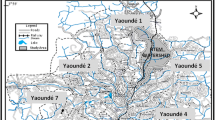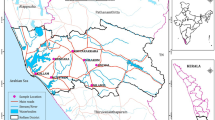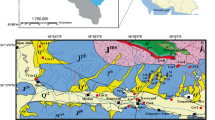Abstract
Soil and groundwater from long-term (>50 years) tannery effluent irrigated areas of Kanpur were analyzed and significant buildup of heavy metals such as Cr, Ni, Cd, Pb, Zn, and As in the range of 252–972, 23–30, 2.3–14.1, 23.7–58.8, 138–338 and 6.8–11 mg kg−1, respectively in soil was found. Few groundwater samples in the effluent irrigated areas also exhibited high Cr concentration above the permissible limit of United States Environmental Protection Agency. The tannery effluents contained 1.53–57.3 ppm Cr, 0–0.12 ppm Ni, 0–0.02 ppm Cd, 0–0.07 ppm Pb, 0–0.48 ppm Zn and 0–0.03 ppm As. The Geo-accumulation index (Igeo) revealed that soil samples were unpolluted to moderately polluted with Cu, Ni, Zn, Pb and As; moderately polluted in case of Cd; and heavily to extremely polluted by Cr.
Similar content being viewed by others
References
Alamgir M, IslamM, Hossain N, Kibria MG, Rahman MM (2015) Assessment of heavy metal contamination in urban soils of Chittagong city, Bangladesh. Intl J Plant Soil Sci 7(6):362–372
Alloway BJ (1995) Heavy metals in soils. Chapman & Hall, London
Ball JW, Izbicki JA (2004) Occurrence of hexavalent chromium in groundwater in the Western Mojave Desert, California. Appl Geochem 19(7):1123
Barnhart J (1997) Occurrences, uses, and properties of chromium. Regul Toxic Pharma 26: 53–57
Chabukdhara M, Nema AK (2012) Assessment of heavy metal contamination in Hindon River sediments: a chemometric and geo chemical approach. Chemo 87:945–953
CPCB (2009) Comprehensive environmental assessment of industrial Clusters. Central Pollution Control Board, Ministry of Environment and Forest, Government of India, p 28. http://www.cpcb.nic.in/upload/NewItems/NewItem_152_Final-Book_2.pdf
Dakiky M, Khami A, Manassra A, Mereb M (2002) Selective adsorption of chromium(VI) in industrial wastewater using low cost abundantly available adsorbents. Adv Environ Res 6(4):533–540
Dhungana TP, Yadav PN (2009) Determination of chromium in tannery effluent and study of adsorption of Cr(VI) on sawdust and charcoal from sugarcane bagasses. J Nepal Chem Soc 23:93–101
Disla SJM, Gomez I, Guerrero C, Navarro-Pedreno J, Mataix-Beneyto J, Jordan MM (2008) Edaphic factors related to heavy metals and nutrients behavior following a single sewage sludge application. Geoph Res Abs 10:00769
Dotaniya ML, Das H, Meena VD (2014) Assessment of chromium efficacy on germination, root elongation, and coleoptile growth of wheat (Triticum aestivum L.) at different growth periods. Environ Monit Assess 186:2957–2963
Dotaniya ML, Saha JK, Meena VD (2015) Sewage water irrigation boon or bane for crop production. Indian Farm 65 (12):24–27
Dotaniya ML, Rajendiran S, Meena VD, Saha JK, Coumar MV, Kundu S, Patra AK (2016) Influence of chromium contamination on carbon mineralization and enzymatic activities in Vertisol. Agric Res. doi:10.1007/s40003-016-0242-6.
Ensink J, Tariq M, Dalsgaard A (2007) Wastewater-irrigated vegetables: market handling versus irrigation water quality. Trop Med Intl Health (London) 12(s2):2–7
Feigin A, Ravina I, Shalhevet J (1991) Irrigation with treated sewage effluent: management for environmental protection. Springer-Verlag, Berlin
Gurjar DS, Yadav BR (2013) Seasonal variation in pH, salinity, nitrate, floride and heavy metals in irrigated soils of Southwest region of Delhi, India. J Ind Soc Soil Sci 61(1):63–66
Gyawali R, Lekhak HD (2006) Chromium tolerance of rice (Oryza sativa L.) cultivars from Kathmandu valley, Nepal. Sci World 4:102–108
Huamain C, Chungrong Z, Cong T, Yongguan Z (1999) Heavy metal pollution in soils in China: status and countermeasures. Ambio 28(2):130–134
Jeyabaskaran KJ, Sree Ramulu US (1996) Distribution of heavy metals in soils of various sewage farms in Tamil Nadu. J Ind Soc Soil Sci 44(3):401–403
Kong SF, Lu B, Ji YQ, Zhao XY, Chen L, Li ZY, Han B, Bai ZP (2011) Levels, risk assessment and sources of PM10 fraction heavy metals in four types dust from a coal-based city. Microchem J 98:280–290
McGrath SP, Chang AC, Page AL, Witter E (1994) Land application of sewage sludge: scientific perspectives of heavy metal loading limits in Europe and the United States. Environ Rev 2:108–118
McLean J, Bledsoe B (1992) Behaviour of metals in soils. Environmental Protection Agency, Washington
Minhas PS, Samra JS (2004) Wastewater use in peri-urban agriculture: impacts and opportunities. Central Soil Salinity Research Institute, Karnal, p 75
Muller G (1969) Index of geoaccumulation in sediments of the Rhine river. Geo J 2:109–118
Naidu R, Harter R (1998) The role of metal organic complexes on metal sorption by soils. Adv Agron 55:219–263
Nakano Y, Takeshita K, Tsutsumi T (2001) Adsorption mechanism of hexavalent chromium by redox within condensed tannin gel. Water Res 35(2):496–500
Page AL, Miller RH, Keeney DR (1982) Methods of soil analysis. Part 2: chemical and microbiological properties. American Society of Agronomy, Madison
Parithabhanu A, Khusnumabegam KJ (2013) The influence of tannery effluent on biochemical constituents in the blood of the fish Oreochromis mossambicus (bloch). Intl J Pure Appl Zool 1(3):227–230
Rattan RK, Datta SP, Chhonkar PK, Suribabu K, Singh AK (2005) Long-term impact of irrigation with sewage effluents on heavy metal content in soils, crops, and groundwater: a case study. Agric Ecosyst Environ 109(3–4):310–322
Sahu RK, Katiyar S, Tiwari J, Kisku GC (2007) Assessment of drain water receiving effluent from tanneries and its impact on soil and plants with particular emphasis on bioaccumulation of heavy metals. J Environ Biol 28(3):685–690
Shanker AK, Cervantes HL, Avudainayagam S (2005) Chromium toxicity in plants. Environ Intl 31:739–753
Sharmila S, Jeyanthi Rebecca L, Saduzzaman Md (2013) Biodegradation of Tannery effluent using Prosopis juliflora. Intl J ChemTech Res 5(5):2186–2192
Sherene T (2010) Mobility and transport of heavy metals in polluted soil environment. Biol Forum Intl J 2(2):112–121
Singh AP, Rao DP (2013) Assessment of tannery effluent: a case study of Kanpur in India. Euro Chem Bull 2(7):461–464
Singh AK, Gupta PL, Agrawal HP (2001) Chromium contamination of water resources and soils and of carpet industrial area of eastern Uttar Pradesh. J Ind Soc Soil Sci 49(4):776–778
Singh KP, Mohan D, Sinha S, Dalwani R (2004) Impact assessment of treated/untreated wastewater toxicants discharged by sewage treatment plants on health agricultural and environmental quality in the wastewater disposal area. Chemosphere 55:227–255
Singh D, Chhonkar PK, Pandey RN (2005) Soil plant water analysis: a methods manual. Westville, New Delhi
Sinha S, Gupta AK, Bhatt K, Pandey K, Rai UN, Singh KP (2006) Distribution of metals in the edible plants grown at Jajmau, Kanpur (India) receiving treated tannery wastewater: relation with physico-chemical properties of the soil. Environ Monit Assess 115:1–22
USEPA (2009) Drinking water contaminants. National primary drinking water regulations. EPA 816-F-09–0004
Walkley A, Black IA (1934) An examination of the Degtjareff method for determining soil organic matter and a proposed modification of the chromic acid titration method. Soil Sci 37:29–38
Wei BG, Yang LS (2010) A review of heavy metal contaminations in urban soils, urban road dusts and agricultural soils from China. Microcheml J 94:99–107
Acknowledgements
Authors are highly thankful to supporting staff of the Division of Environmental Soil Science, ICAR-Indian Institute of Soil Science, Bhopal for necessary help during the study. Authors are also thankful to Dr. S. R. Mohanty for valuable comments. This study is a part of the project “Tannery constituent interaction effect on spinach” and funded by ICAR-Indian Institute of Soil Science, Bhopal (Grant No. IXX07989).
Author information
Authors and Affiliations
Corresponding author
Rights and permissions
About this article
Cite this article
Dotaniya, M.L., Meena, V.D., Rajendiran, S. et al. Geo-Accumulation Indices of Heavy Metals in Soil and Groundwater of Kanpur, India Under Long Term Irrigation of Tannery Effluent. Bull Environ Contam Toxicol 98, 706–711 (2017). https://doi.org/10.1007/s00128-016-1983-4
Received:
Accepted:
Published:
Issue Date:
DOI: https://doi.org/10.1007/s00128-016-1983-4




